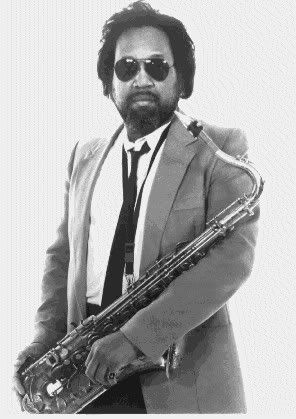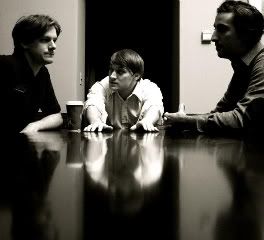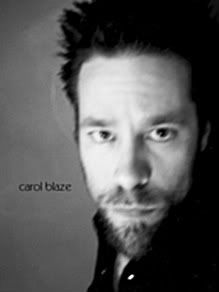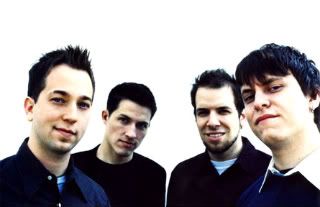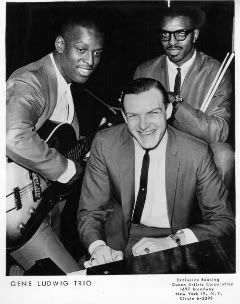
Jerry Byrd, Gene Ludwig, and Randy Gillespie in 1964
Being Halloween and all, Old Mon couldn't resist posting a little haunting organ music for today's entry. And who better to deliver it than Gene Ludwig?
On September 4th, 1937, the coal-mining hamlet of Twin Rocks in Cambria County welcomed young Eugene Ludwig into the world. And while you may not have heard of him unless you're a local jazz fan, rest assured that Ludwig is one of the monsters of the Hammond B-3 organ.
Four years after he was born, his father took a job at Westinghouse Electric and moved the family to Wilkinsburg and then Swissvale, where Ludwig spent most of his youth. And yah, this all does have something to do with his career as a B-3 burner.
The previous owners of the Swissvale crib left an old piano behind, and that beat-up set of 88s was Ludwig's launching pad. His mom, Mary, could see he was a natural at the ivories, and dreamed of her son becoming a classical pianist.
At age 6, Ludwig started taking lessons, but momma's hopes took a hit when as a high-school kid, he discovered Porky Chedwick on WHOD. A steady dose of Ruth Brown, Big Joe Turner, Bill Doggett and Wild Bill Davis turned him away from big-band sounds to the R&B scene.
He still cites "Honky Tonk" by Bill Doggett, "The Sermon" by Jimmy Smith, and "I Got A Woman" by Jimmy McGriff as songs that inspired him and his career.
In 1955, he graduated from Swissvale High and went to Edinboro State Teacher's College, where he studied physics and math (and to this day, Ludwig still looks more like a professor than a jazzman).
But Westinghouse went on strike, and with his dad out of a pay check, Ludwig dropped out and started to earn his own way in the world. He returned to Pittsburgh, and got a gig with Fuller Construction.
He became a habitue at Birdie Dunlap's Hurricane Bar in the Hill, where he was exposed to keyboardists like Jack McDuff, Johnny Hammond Smith, Groove Holmes, Jimmy McGriff, Horace Silver, Ray Bryant, Ahmad Jamal, and Ramsey Lewis.
One night in 1957 at the Hurricane, he saw Jimmy Smith perform, making magic with his B-3 Hammond, and he was wowed.
Ludwig eventually purchased a Hammond M100 organ and later a C Model, branching out his keyboard repertoire after Smith showed him the light. Ludwig was bitten hard by the bug, and eventually started performing as a sideman with groups around town and then forming his own band.
In fact, his trio - Ludwig, drummer Randy Gillespie and guitarist Jerry Byrd - played Birdie's club from 1962 until it closed in 1968, a victim of the Arena project and the Martin Luther King riots. They also played some east coast gigs, and etched some wax for LaVere. Ludwig even hit the chitlin' circuit.
As he recalled for Bill Milkowski of JazzTimes: "It was beautiful. I didn't encounter any problems at all. I was up there playing and we always got return invites to all these places - the Hubbub in Indianapolis, the Key Club in Newark, Count Basie's in Harlem, Lennie's on the Turnpike and the Shanty in Boston. The people liked us."
Ludwig hooked up with tenor saxophonist Sonny Stenton and hit the area club circuit. They gigged in local venues like the Hi-Hat on the Northside, Mason's in the Hill, Tropics in Braddock and Dave's Walnut Inn in McKeesport, even scoring some dates in Cleveland.
Getting a taste of the gypsy life, Ludwig jumped ship and joined up with another saxman, Gene Barr. Barr's band toured heavily, performing in St. Louis, Indianapolis, Philadelphia and Buffalo.
Over time, Ludwig transitioned full monty from the piano to the organ. During a 1964 Atlantic City show, he played on the same bill with Smith, who used Ludwig's C Model.
After the show, Smith told him he should try to get a B-3 because the C Model, a smaller, open-legged instrument, would work him to death. Ludwig returned to Pittsburgh, bought a B-3, and played with his trio (Wilbert Longmire eventually replaced Byrd, and then Pat Martino took Longmire's spot). They traveled to Count Basie's club in Harlem, the 100 Club in Cleveland and other jazz venues around the East.
During a gig in Newark, New Jersey, Nesuhi Ertegun (Ahmet's brother) of Atlantic Records caught the band in action, and he signed Ludwig and the trio to cut a 45, "Sticks And Stones," which led to the "Organ Out Loud" LP for Milestone Records (#6032).
In 1966, "Mother Blues" was released on the Jo-Da label, and Ludwig's own label, Ge-Lu Records, issued "This is Gene Ludwig" (GL-1415).
In 1969, Ludwig replaced Don Patterson in Sonny Stitt's band for a year, long enough to cut "Night Letter" with the group for Prestige Records. Though he left the band, he would sit in with Stitt over the years.
Ludwig returned to Pittsburgh and started working regularly with saxophonist Bill Easley and later, Walt Maddox. He took to the road with big band crooner Arthur Prysock a couple of times, once for a year beginning in 1973 and again in 1978.
David Parr of the La Rells, who was also a sound engineer, remembers one session loaded with superstar talent. In 1974, he taped “Dancing on a Daydream” by Flora Wilson. One of the backing singers was Phyllis Hyman.
But the jocks turned the record over, and the big hit was the instrumental B side, done by the Sound of Philadelphia Orchestra, credited to the Soulvation Army Band. Parr taped the flip side in Philly, and added some sugar in Pittsburgh. He had sax man George Green honk for him, and Gene Ludwig pumped the B-3.
Phyllis Hyman backing on the vocal track and Gene Ludwig on the B side? Hey, ya gotta be kiddin'! Pittsburgh sure had some sidemen back in the day.
Although he got his share of club dates and was a popular session player, the era of the organ was winding down. He was turning down gigs that wanted him to mellow out (he remained true to jazz and R&B), and it looked like the Hammond players were fast becoming an endangered species.
That is, until Joey DeFrancesco, Papa John's kid, fueled a resurgence with a series of Columbia albums running form 1989 through the nineties and revived the genre.
Throughout the '80s and '90s, Ludwig's schedule picked up, and he toured the eastern and midwestern circuits while working in local jazz clubs like the Crawford Grill and James Street Tavern.
He appeared at the Montreaux Jazz Festival. He's honky-tonked at the San Francisco Jazz Festival, Birdland in NYC, the Stanford Jazz Festival, and Newark's Jazz Organ Jam. Ludwig has gigged at the Blue Note in Las Vegas, Philly's Zanzibar Blue, and Trumpet's in Jersey.
Dizzie Gillespie, Jimmy Smith, Charles Earland, Don Patterson, Nancy Wilson, Barbara McNair, Damita Jo, and Ester Philips are some of the artists he's shared stages with during his career. He played at the Mellon Jazz Festival.
Locally, Ludwig organized his own Jazz Organ Jams at Shadyside's Balcony club, where he had a regular gig until it closed its doors a decade ago. Ludwig and fellow Hammond B3 giants, Jack McDuff, Joey DeFrancesco and Papa John DeFrancesco, put together a super-group performance there that they called "ExtravOrganza."
And hey, he's kept busy even as the jazz joints become fewer. In the past few months, he's rocked the Rhythm House in Bridgeville, Blue in McCandless, Morgan's Restaurant in Penn Hills, The Sweetwater Center For The Arts in Sewickley, The Backstage Bar, Downtown, and Pangea in Shadyside.
That's a pretty active schedule, we think, for a guy that's in his seventies, has 50 years in the business, and lugs around a 400 pound instrument.
The last decade has seen a flood of tracks being laid down by Ludwig, too. With the release of his 1998 "Back on the Track" CD, the gates opened.
Five other CD's have since hit the market: "Soul Serenade" in 2000, "The Groove Organization" in 2002, "Hands On" in 2004, "Live in Las Vegas" in 2006 and “Duff’s Blues: Live at Zoellner Art Center” in 2008.
Oh, and Ludwig was recognized by the Manchester Craftsman Guild as a "Jazz Legend" last year with eight other local giants during its 40th anniversary bash. He even found time to marry Pattye Zamborsky on September 30, 2000.
Now about that national recognition thing. It's an out-of-sight, out-of-mind conundrum, and in the east, if you're not in New York, you're nowhere.
Marty Ashby of the Manchester Guild said of Ludwig and his home boys: "These are the people who have stayed in Pittsburgh, who could have been anywhere in the world, and they elected to stay here and pass the tradition and the language of this music on to future generations."
Jazz producer Bob Porter told the Jazz Times that "To a certain extent, if you are a local musician, you’re either so good that you’re always working or you’re not good enough to travel. There’s no real middle ground. And Gene is just one of these guys who is so good, and his reputation is so strong around Pittsburgh, that he really didn’t have to come out that much." Amen to that.
"I chose to stay in Pittsburgh for my home because I love this city and my many friends and fellow musicians here," Ludwig wrote on the Pittsburgh Jazz Network. "I haven't found as rich a source of great musicians as in Pittsburgh."
Pittsburgh has been the mother lode of jazz for longer than Old Mon has been alive (and yes, that's a long time), and will be as long as guys like Gene Ludwig are here to pass on the torch to the next wave of be-boppers.
EDIT - The next generation will have to do without Gene Ludwig; he passed away on July 15th, 2010, at the age of 72.
Gene Ludwig live at Zanzibar Blue - "I Got A Woman"
